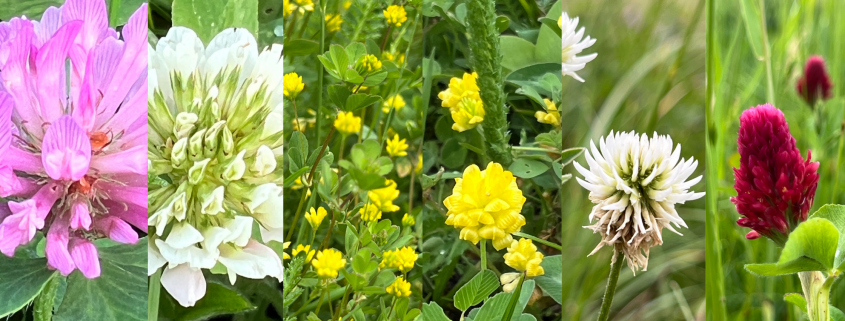Do you know this clover?
In the summertime, you can find clover in meadows, along paths, or in fields. It comes in red, yellow, or white varieties. However, the diversity of clover species is much greater than many people realize. In this story, we want to introduce you to six different representatives of the plant genus Trifolium, which are widespread in large parts of Europe. We hope this encourages you to take a closer look the next time you come across a “clover” on your next walk. This story is the result of a school internship, and we would like to extend our sincere thanks to Maike for her research and writing.
Red meadow clover (Trifolium pratense)
Red meadow clover or red clover Trifolium pratense can be found everywhere: in gardens, meadows, forests and along roadsides and field edges. Thanks to its attractive red to purple flowers, which are full of nectar, the red meadow clover is sought out by many butterflies, such as the lady butterfly, as a food source and also as a caterpillar plant. It flowers from April to October, forming a multi-flowered spherical inflorescence covered by the uppermost stem leaves. This type of clover is rich in protein, making it a popular food plant. Additionally, red meadow clover is edible for humans and has earned a reputation as a medicinal plant. It has been used internally and externally for a variety of ailments since the 11th century.
White clover (Trifolium repens)
White clover Trifolium repens, like all the other species presented here, belongs to the legume family and the papilionaceous subfamily. Its flowers and leaves are similar to those of red clover, except that the flowers have a (eponymous) white color. Each of the 40-80 individual flowers in the inflorescence produces 3 to 4 seeds, which are egg-shaped to roundish and orange-yellow. The four-leaf clovers, which are considered lucky charms, are rarely found among wild plants. However, there is a cultivated variety for gardens and balcony boxes, the “four-leaved chocolate clover” (Trifolium repens ‘Quadrifolium Purpureum’), which is easy to care for and is predominantly four-leaved.
Small clover (Trifolium dubium)
This species is widespread throughout Europe. It can be found in meadows, pastures or garden lawns. Its yellow flower turns brownish when the fruit ripens. The small clover Trifolium dubium is considered a forage plant and is often visited by insects such as bumblebees for pollination. If you only take a quick glance, you could confuse it with Medicago lupulina – in this case, identification with Flora Incognita or examination of the calyx will help. The calyx of the small clover is glabrous, while that of the hop clover is hairy.
Field clover (Trifolium campestre)
This member of the family has small, yellowish, shell-like flowers. Known as “butterfly flowers with a folding mechanism,” they have areas that absorb ultraviolet light and others that reflect it. This makes them appear two-colored to pollinators such as honeybees, flies, or butterflies. The field clover Trifolium campestre thrives on sandy, loamy, or stony soils, as well as on meager meadows, where it is considered a fodder plant. It avoids nitrogen-rich subsoils, making it an indicator plant for nitrogen-poor soil.
Mountain clover (Trifolium montanum)
Mountain clover Trifolium montanum is found throughout Europe, but can also climb to high altitudes – which gave it its name. For example, it can be found on the Jöchelspitze in Tyrol at an altitude of 2226 m, and in Valais in Switzerland it has been observed at 2560 m. Due to its white to yellowish-white flower color and the typical round shape of the inflorescences, it is easy to confuse with the more common white clover. However, the mountain clover grows more upright and has a hairy stem and longer, lanceolate leaves. Its habitat requirements are also different. White clover is a generalist, but mountain clover grows on semi-arid and dry grassland in warm locations with clayey-humus soils.
Incarnate clover (Trifolium incarnatum)
The incarnate clover Trifolium incarnatum is also known as Italian clover, as its original distribution area covers the Mediterranean region, including Italy. Today, however, it can also be found in Germany, mainly in areas without spring frosts, as it does not tolerate them well; and it is cultivated as a popular forage plant in large parts of Europe. The leaves of the incarnate clover are very large for a clover species, but its most striking feature is probably its flower color. The deep purple-red flower heads, which are elongated spikes in this species, appear from May to August.
This article was featured as a story in the Flora Incognita app in 2024. In the plant identification app, you will always find exciting information about plants, ecology, species knowledge, as well as tips and tricks for plant identification. Take a look!

